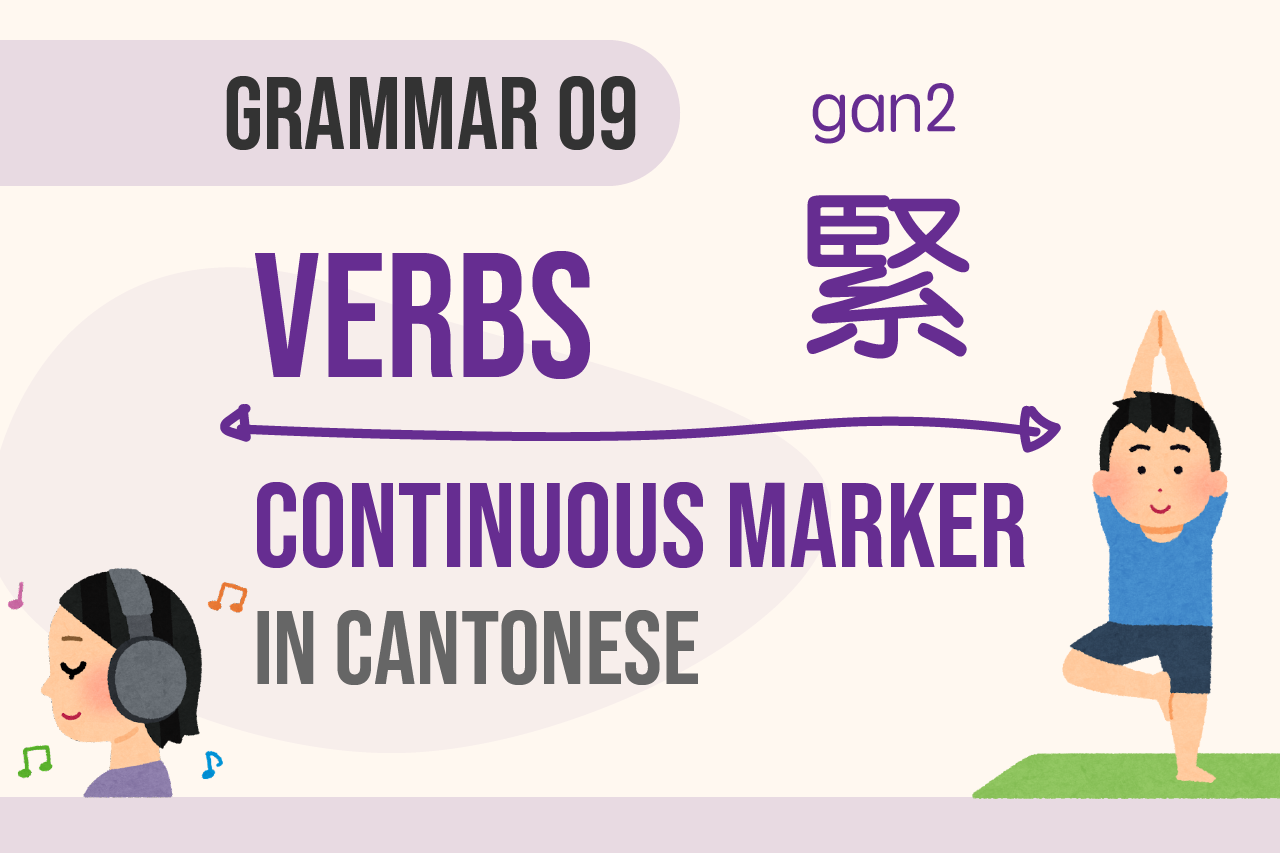Table of Content
Similar to the neutral aspect, in Cantonese, we use the Subject-Verb-Object (SVO) structure and add the marker 緊 after the verb to indicate continuous actions, much like adding "ing" to verbs in English.
This “chopped pattern of Verb-Object” in continuous aspect exists only in Cantonese. In Mandarin, 正/在 is used in front of the verb to indicate continuous actions.
This marker can apply to both present and past actions, with the context and supporting words determining whether the action is present or past.
緊 is sometimes regarded as a "Progressive Marker," while 住 is considered a "Continuous Marker" in some classifications. Since most of the time the continuous "ing" in English is translated as 緊 in Cantonese, we choose to classify 緊 as a continuous marker and 住 as a durative marker.
Question
【Subject - 係唔係 - Verb - 緊 - (Object/Noun)】?
Refer to Grammar01 - 係(hai6) for the meaning of 係唔係
你係唔係睇緊電視呀?
Are you watching TV?佢哋係唔係瞓緊覺呀?
Are they sleeping?你係唔係沖緊涼呀?
Are you taking a shower?佢哋係唔係考慮緊呀?
Are they considering (it)?
Single-Character Verb
Verbs with Direct Objects
(+ve)【Subject - Verb - 緊 - Object】
(-ve)【Subject - 唔係 - Verb - 緊 - Object】
(我睇電視)
(I watch TV.)我睇緊電視
I am watching TV.我唔係睇緊電視
I am not watching TV.(佢做瑜珈)
(He/She does Yoga.)佢做緊瑜珈
He/She is doing Yoga.佢唔係做緊瑜珈
He/She is not doing Yoga.(你哋聽歌)
(You guys listen to music(/songs).)你哋而家聽緊歌
You guys are listening to music(/songs) now.你哋而家唔係聽緊歌
You guys are not listening to music(/songs) now.(佢哋畫畫)
(They draw (pictures).)佢哋啱啱畫緊畫
They were drawing (pictures) a moment ago.佢哋啱啱唔係畫緊畫
They were not drawing (pictures) a moment ago.
Verbs with Complementing Noun
(+ve)【Subject - [Verb - 緊 - Noun]】
(-ve)【Subject - 唔係 - [Verb - 緊 - Noun]】
Some verbs, usually intransitive in English, are combined with a noun character to form a "verb-noun phrase," which functions as a single verb to make the sentence sound more complete. Logically, the noun is not the directed object of the verb, but grammatically functions like an object.
For example, 跑步 (to run), where 跑 means "to run" and 步 means "steps," literally translates to "running steps." You may refer to Grammar08 - Cantonese Verbs for more about this complementing noun.
When indicating continuous actions of these verbs, 緊 should be inserted between the verb and the noun character.
(我哋瞓覺)
(We sleep.)我哋瞓緊覺
We are sleeping.我哋唔係瞓緊覺
We are not sleeping.(你跑步)
(You run/jog.)你頭先跑緊步
You were running/jogging a moment ago.你頭先唔係跑緊步
You were not running/jogging a moment ago.(我食飯)
(I eat.)
我食緊飯
I am eating.我唔係食緊飯
I am not eating.
Double-Character Verbs
You may refer to Grammar08 - Cantonese Verbs for more about the definition of double-character verbs.
Separable Verbs
Similar to verbs with complementing noun, aspect markers are placed between the verb and noun in separable double-character verbs.
The reason we explain these two types of verbs separately is that in intransitive verbs, the main verb still exists in the first character, but you cannot derive the meaning of the double-character verb from its first character alone. You can see that we cannot mark the corresponding English word as the same color as the first character, since the verb itself does not have the meaning of the combined form.
【Subject - [Separable Double-Character Verb] 】
(+ve)【Subject - [Verb - 緊 - Noun]】
(-ve)【Subject - 唔係 - [Verb - 緊 - Noun]】
我沖緊涼
I am taking a shower.我唔係沖緊涼
I am not taking a shower.(沖 - to rinse, to rush|涼 - refreshing, cool)
我行緊街
I am window shopping (as a leisurely activity) / strolling around / shopping.我唔係行緊街
I am not window shopping (as a leisurely activity) / strolling around / shopping.(行 - to walk|街 - street)
佢哋吹緊水
They are chitchating.佢哋唔係吹緊水
They are not chitchating.(吹 - to blow|水 - water)
Non-separable Verbs
Most verbs follow the above pattern. However, non-separable verbs are not “chopped” into two parts when a verb aspect marker is used.
(+ve)【Subject - [Non-separable Double-Character Verb] - 緊 】
(-ve)【Subject - 唔係 - [Non-separable Double-Character Verb] - 緊 】
(佢考慮)
(He/She considers.)佢考慮緊
He/She is considering.佢唔係考慮緊
He/She is not considering.(我攤唞)
(I rest.)我攤唞緊
I am resting.我唔係攤唞緊
I am not resting.(呢間公司擴展)
(This company expands.)呢間公司擴展緊
This company is expanding.呢間公司唔係擴展緊
This company is not expanding.
Additional Notes
One way to determine whether a verb is a “verb-noun phrase” or a non-separable double-character verb is to observe if one of the characters can be omitted.
For example, sometimes people say 我去瞓覺先啦 (I’ll go sleep first) as 我去瞓先啦 or 你哋唔好吹咁耐水啦 (Don't chitchat for so long) as 你哋唔好吹咁耐啦, where 覺 and 水 can be omitted.
However, when it comes to 考慮, since 慮 is not a noun character, it cannot be omitted. It is incorrect to say I’ll consider it a bit as 我會考吓 without the 慮. Instead, you should say 我會考慮吓.
For future actions, we do not typically use the continuous marker in Cantonese. For example, "She will be speaking this evening" translates to 佢今晚會演講, where 會 indicates a future action without specifying if the action is continuous.
